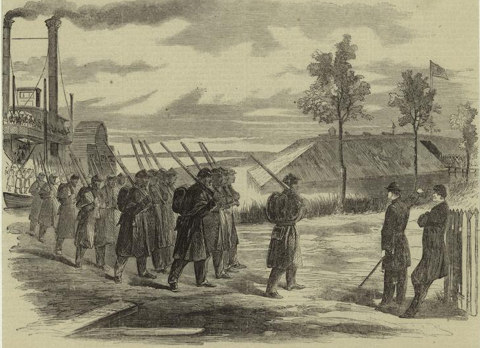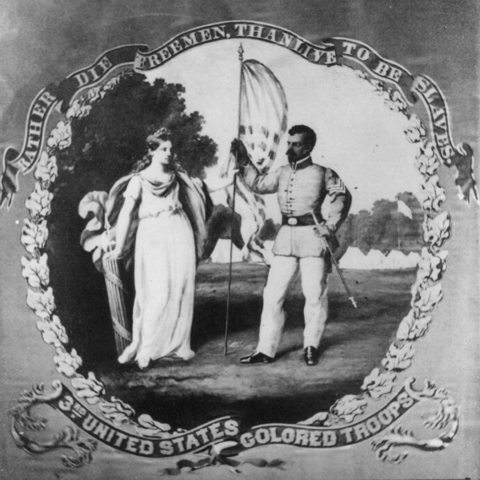Nearly 180,000 free black men and escaped slaves served in the Union Army during the Civil War. But at first they were denied the right to fight by a prejudiced public and a reluctant government. Even after they eventually entered the Union ranks, black soldiers continued to struggle for equal treatment. Placed in racially segregated infantry, artillery, and cavalry regiments, these troops were almost always led by white officers.
 |
|
Native Louisiana Guards volunteered for the Union Army and formed the first unofficial units of black troops. (Wikimedia Commons) |
‘We Are Ready and Would Go’
As soon as the Civil War began, many free black men in the North wanted to fight for the Union cause. Frederick Douglass, who escaped slavery to become a famous abolitionist leader, stated “We are ready and would go.” But prejudice against black people — both free and slave — was strong and deep in the North as well as the South.
Most white Americans at this time thought of black adults as children, lacking in mental ability and discipline. Slavery had stripped black men of their manhood, so the thinking went, making them dependent and irresponsible. These stereotypes led most whites to assume that a black man could never be trained to fight like a white soldier.
During the early part of the war, President Lincoln opposed accepting blacks into the army. He said that this would push border states like Missouri over to the Confederacy. In effect, both free black men and escaped slaves were banned from the Union Army.
Major General Benjamin Butler commanded the Union forces that had captured and occupied New Orleans in the spring of 1862. The Confederate government of Louisiana had formed a militia consisting of free black men led by their own officers. This all-black militia came to Butler and volunteered to join the Union Army. He transformed the Confederate militia into the First Regiment Native Louisiana Guards led by black captains and lieutenants. He later went on to form two more black regiments, which were commanded by white officers. These became the first, though unofficial, units of black troops in the Union Army.
In July 1862, Congress passed a law permitting black men to enlist at a pay rate of $10 per month ($3 less than the pay of a white private). But Congress left it up to the president to determine the duties of black volunteers. Lincoln decided that any blacks enlisting into the army were to be used only as laborers and not trained as combat soldiers.
By the end of 1862, it was clear that the war was not going to end quickly. As this harsh reality began to sink in, the number of Northern white volunteers dropped considerably. Moreover, Lincoln realized that once the war ended and the Union was restored, slavery could never continue. As Frederick Douglass had argued all along, slavery was “the source and center of this gigantic rebellion.” For these and other reasons, Lincoln made a dramatic shift in Union war policy on January 1, 1863 when he announced the Emancipation Proclamation.
Lincoln’s Emancipation Proclamation liberated slaves in those areas still in rebellion. It went on to announce that free black men “will be received into the armed services of the United States....”
In the spring, the War Department organized the Bureau of Colored Troops. The bureau began a massive army recruitment program aimed at free blacks in the North and emancipated slaves in Union-held Southern territory. All the new regiments of U.S. Colored Troops were led by white officers, recruited from existing regular army units.
 |
|
A banner of a unit of black troops. (Wikimedia Commons) |
Proving Themselves
In May and June 1863, black and white Union regiments fought for the first time in major battles at Port Hudson and Milliken’s Bend on the Mississippi River. One unit fighting was Gen. Butler’s First Regiment Native Louisiana Guards led by black officers, including one 16-year-old lieutenant who was killed in action. Some of the white officers expressed surprise at how fiercely the black troops fought. But black soldiers were fighting for much more than restoring the Union. They were fighting to liberate their people.
Black soldiers soon got to prove their fighting ability even more dramatically. On July 18, 1863, the 54th Massachusetts Infantry led the assault on Fort Wagner, a Confederate stronghold guarding the entrance to Charleston Harbor. The 54th Infantry Division was made up mainly of free Northern black men (including two of Frederick Douglass’s sons). The regiment was commanded by an idealistic 25-year-old white officer, Colonel Robert Gould Shaw.
Despite heavy artillery and rifle fire, the men made a furious charge on the Fort and engaged its Confederate defenders in brutal hand-to-hand combat. Finally driven back, the 54th suffered 40-percent casualties. Col. Shaw was killed during the charge and was buried with his men. Reported widely in Northern newspapers, the story of the heroic actions of the 54th Massachusetts Infantry at Fort Wagner helped to turn public opinion around in favor of blacks in the Union Army.
Combat for both black soldiers and their white officers was doubly dangerous. When captured by the Confederates, black captives could be returned to their previous owners, sold into slavery, or even hanged. Their white officers were considered “outlaws” and might be executed upon capture, rather than kept and treated as prisoners of war.
Despite their proven record as effective, courageous combat troops, African-American men still faced a long struggle for equal treatment. During the Civil War, black troops were often assigned tough, dirty jobs like digging trenches. Black regiments were commonly issued inferior equipment and were sometimes given inadequate medical treatment in racially segregated hospitals. African-American troops were paid less than white soldiers. Some black units, such as the 54th Massachusetts Infantry, refused to accept any pay as long as the rate remained unequal. The Lincoln administration and Congress dragged their feet on this matter until they finally established equal pay near the war’s end.
Other inequalities plagued black troops. Few African Americans were commissioned as officers and black troops remained in segregated units throughout the Civil War. In fact, African-American troops were not integrated with their fellow Americans until the Korean War nearly 100 years later.
Despite the inequality, the black troops in Union blue had proven themselves to be courageous, effective soldiers. Black soldiers, including more than a dozen Congressional Medal of Honor winners, fought in 449 Civil War battles. More than one-third of them died during the war. Through their courage and sacrifice, these black men helped press the African-American fight for equality.
For Discussion and Writing
- Why do you think Lincoln objected to the enlistment of black men into the Union Army at the beginning of the war? Why do you think he changed his position in the Emancipation Proclamation?
- In what ways were black soldiers not treated equally in the Union Army?
- What important things do you think black soldiers proved in the Civil War?
For Further Reading
Cornish, Dudley Taylor & Herman Hattaway. The Sable Arm: Black Troops in the Union Army, 1861–1865. Lawrence, Kan.: University Press of Kansas, 1990.
Glatthaar, Joseph T. Forged in Battle, The Civil War Alliance of Black Soldiers and White Officers. New York: The Free Press, 2000.
A C T I V I T Y
Frederick Douglass’s Paper
During the Civil War, black abolitionist Frederick Douglass produced a newspaper called Frederick Douglass’s Paper. In this activity, the class will write and publish an issue of Frederick Douglass’s Paper, reflecting some of the important controversies concerning black troops in the Union Army.
A. Form six editorial teams. Each team will be responsible for writing one of the following newspaper articles:
- A news article reporting Lincoln’s Emancipation Proclamation
- A first-person account of a black soldier’s experience in combat
- A petition to President Lincoln by the 54th Massachusetts Infantry listing arguments for equal pay
- A letter to the editor from a white Union Army officer criticizing the Confederate prisoner of war policy regarding black troops and their white officers
- A U.S. Army recruitment advertisement aimed at free black men and emancipated slaves
- An editorial by Frederick Douglass concerning the equal rights that black people should be guaranteed once the war is over
B. The six parts should be typed and reproduced in a simple newspaper format for all the students in the class to read.
C. Each editorial team should report to the class the most important thing the members learned about their particular topic.


